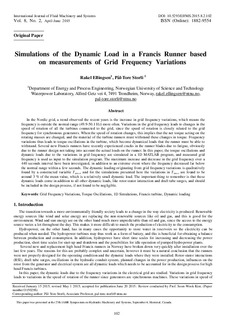Simulations of the dynamic load in a francis runner based on measurements of grid frequency variations
Journal article, Peer reviewed
Published version
Permanent lenke
http://hdl.handle.net/11250/2468698Utgivelsesdato
2015Metadata
Vis full innførselSamlinger
Originalversjon
International Journal of Fluid Machinery and Systems. 2015, 8 (2), 102-112. 10.5293/IJFMS.2015.8.2.102Sammendrag
In the Nordic grid, a trend observed the recent years is the increase in grid frequency variations, which means the frequency is outside the normal range (49.9-50.1 Hz) more often. Variations in the grid frequency leads to changes in the speed of rotation of all the turbines connected to the grid, since the speed of rotation is closely related to the grid frequency for synchronous generators. When the speed of rotation changes, this implies that the net torque acting on the rotating masses are changed, and the material of the turbine runners must withstand these changes in torque. Frequency variations thus leads to torque oscillations in the turbine, which become dynamical loads that the runner must be able to withstand. Several new Francis runners have recently experienced cracks in the runner blades due to fatigue, obviously due to the runner design not taking into account the actual loads on the runner. In this paper, the torque oscillations and dynamic loads due to the variations in grid frequency are simulated in a 1D MATLAB program, and measured grid frequency is used as input to the simulation program. The maximum increase and decrease in the grid frequency over a 440 seconds interval have been investigated, in addition to an extreme event where the frequency decreased far below the normal range within a few seconds. The dynamic loading originating from grid frequency variations is qualitatively found by a constructed variable Tstress, and for the simulations presented here the variations in Tstress are found to be around 3 % of the mean value, which is a relatively small dynamic load. The important thing to remember is that these dynamic loads come in addition to all other dynamic loads, like rotor-stator interaction and draft tube surges, and should be included in the design process, if not found to be negligible.
